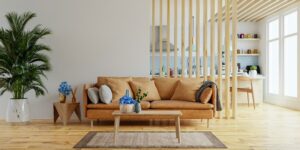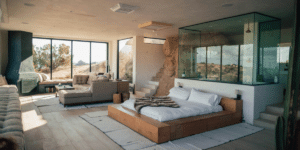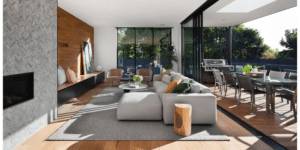What Defines Modern Design?
At its core, modern design is all about simplicity and functionality. The style emerged in the early to mid-20th century as a reaction to the ornate, heavily decorative styles that dominated earlier periods. Influenced by the Bauhaus movement and Scandinavian design, modern design values clean lines, a lack of embellishment, and an emphasis on practicality.
A hallmark of modern design is the use of open spaces. Rooms are often free-flowing, with fewer walls separating different areas of the home. This open layout creates a sense of continuity, allowing light to travel more freely and making the space feel larger. Furniture in a modern design is often minimalistic, with pieces that focus more on function than decoration. The simplicity in furniture design allows for greater ease of movement and usage without overwhelming the senses.
Another key aspect of modern design is the use of natural materials. Wood, metal, glass, and stone are commonly found in modern interiors, and they are often left in their raw or minimally treated form. This approach not only celebrates the natural beauty of materials but also aligns with the modern philosophy of using materials for their inherent qualities. For instance, wood might be showcased in its natural grain, or metal might be left with a brushed finish to highlight its texture.
Why Is Modern Design So Popular?
The popularity of modern design can be attributed to its timeless appeal and practical benefits. In a world that is increasingly fast-paced and cluttered, many people are drawn to the simplicity and calm that modern spaces offer. Homes designed with a modern approach feel more open and less chaotic, which can create a sense of serenity for those living in them.
One of the reasons people gravitate towards modern design is its focus on functionality. Every element in a modern home serves a purpose, and there is little room for excess. This practical mindset means that modern design often incorporates clever storage solutions and multi-functional furniture pieces, making it ideal for smaller spaces or urban living. For example, a sleek sofa in a modern living room may have hidden storage underneath, or a dining table may double as a workspace.
Additionally, the minimalist aesthetic of modern design offers flexibility. The clean lines and neutral color palettes create a backdrop that allows homeowners to add their own personal touches through art, textiles, and other decor. Modern spaces are often designed to be adaptable, meaning they can evolve over time as tastes change or new pieces are introduced.
The rise of environmental awareness has also played a role in the continued popularity of modern design. The emphasis on using natural materials and reducing clutter aligns with the sustainable lifestyle that many people are adopting. Whether it’s choosing furniture made from eco-friendly materials or designing a space with energy efficiency in mind, modern design allows homeowners to make conscious choices that benefit both their environment and their personal well-being.
How to Achieve a Modern Look in Your Home?
Achieving a modern design in your home doesn’t require a complete overhaul. By focusing on a few key principles, you can transform your space to reflect the simplicity and functionality that modern design is known for.
Start by focusing on the layout of your home. Modern design emphasizes open spaces, so consider removing unnecessary barriers between rooms to create a more fluid living area. If knocking down walls isn’t an option, you can still achieve an open feel by choosing furniture that doesn’t block the flow of light or impede movement. For example, opt for low-profile sofas and armchairs that keep the space feeling airy.
Next, embrace a neutral color palette. Modern design often leans toward whites, grays, and earthy tones, allowing the focus to remain on the form and function of the space rather than the color. That doesn’t mean you have to avoid color entirely—modern design welcomes pops of color in small doses. You might introduce a bold color through a single piece of furniture, an area rug, or a piece of artwork, adding personality without overpowering the room.
When it comes to furniture and decor, less is more. Choose pieces that are simple, functional, and sleek. Avoid overly ornate or decorative items, and instead, opt for furnishings that have clean lines and serve a purpose. For example, a modern coffee table might have an angular design and double as extra storage. Lighting is another key element of modern design—choose light fixtures that are understated but stylish, such as pendant lights or sleek floor lamps.
Lastly, prioritize natural materials and finishes. Incorporating materials like wood, glass, and metal can add warmth and texture to your modern space while maintaining the clean, minimalist aesthetic. A natural wood dining table or exposed metal beams can make a bold statement in a modern home without feeling out of place.
Modern design is a celebration of simplicity, functionality, and natural beauty. Its clean lines, open spaces, and minimalist approach create a timeless aesthetic that appeals to those looking for a sense of calm and clarity in their homes. By understanding the principles of modern design and incorporating them thoughtfully, you can create a space that is not only visually appealing but also practical for everyday living. Whether you’re redesigning your entire home or making small updates, embracing the essence of modern design can help you achieve a harmonious, clutter-free environment.













